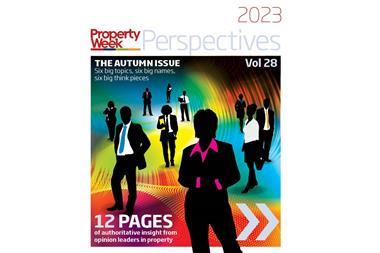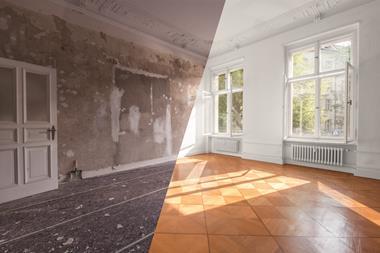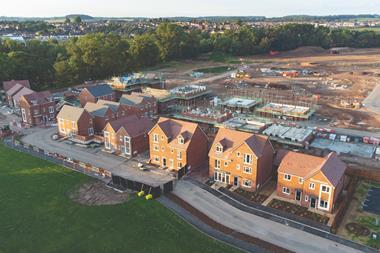Digital technology has completely revolutionised the way we live, work and play. The pace of change has been so rapid that many sectors of the economy are still figuring out how best to deploy innovation. Property management is no exception.

At Bellrock, we believe we have developed a means of harnessing the potential of both artificial intelligence (AI) and the ‘Internet of Things’ (IoT) in order to make managing buildings – indeed, whole portfolios – vastly more efficient and effective. Here’s how.
For those that do not know, Bellrock is an estate risk management business that employs around 1,000 people and manages estates up and down the country in both the commercial and public sectors. It is responsible for around £1.3bn of property and facilities management spend across approximately 150,000 sites.
At Bellrock, we try to help our customers manage their operational risk through both reactive and planned events, ensuring that their property assets do not break down and instead perform in a way that supports their overall strategies. Put simply, we look at estates and ask what we can do to improve risk outcomes for clients.
This is different to expressions such as “we look after properties” or “we look after property portfolios”, which are another way of claiming to be the best cleaner, security guard or estate agent in the world. That is quite a different proposition.
Estate risk comes in various forms, from operational to legal and reputational to financial. We advise our customers on the best value for money for their estate and the way they run it. That can be anything from service charges and rental fees through to the cost of heating and ventilation systems and which provider is best placed to support them.
Crucially, we own our own software suite, known as Concerto, which we increasingly use to deliver tangible improvements to the ways our clients’ portfolios are managed. Fusing together risk management and software knowledge, we can quickly and easily evolve the platform for our customers. The latest evolution is IoT.
In some ways, smart buildings and AI have been around for a while. It is just that we used to refer to the technology as a building management system (BMS). The idea that a piece of equipment feeds back to a central control and tells it that something is too hot or too cold or that there is too much or too little moisture – or whatever the trigger might be – is not new.
What is new, however, is that things that are not directly connected to a BMS can be measured and monitored cheaply. Relatively low-cost monitoring devices can realistically enhance the BMS ecosphere.
Another change is that building management or IoT outcomes can be linked to a workflow engine such as Concerto. Previously, if a sensor detected that a room was too hot, for instance, action would only be taken if an engineer happened to be looking at the BMS. With Concerto, the system automatically alerts an engineer, who then takes action and issues a message or certificate once the issue is resolved.
Proactive facilities management
As a result, equipment can be serviced or replaced before it breaks down and causes serious issues for building owners and occupiers. We call this proactive facilities management. For the first time, reactive maintenance can be carried out without anyone having to pick up a phone or take proactive action.
That is fantastic, but the IoT enables so many things to be measured that it can be difficult to see the wood for the trees. The technology now exists to record how many people are sitting around a desk, how many times a piece of equipment has been used or even how many times a toilet has been flushed (that last example is not a joke).
The critical question, therefore, is what information is actually useful to an asset’s owner or occupier. For instance, for a company such as Regus or WeWork, knowing how many people are in a room and how they are using it really matters, because understanding how users interact with the space is essential to the success of their business models. A large government department that owns its assets, on the other hand, may have less need for such information.

Before working out what AI and IoT can do, there needs to be an understanding of what problems need to be solved. That is what we do at Bellrock. We try to understand the key estate risks and then manage the appropriate responses. We take our customers through a process that creates a picture of their estate in a digital format rather than on a piece of paper. We map a rules engine against it and then set up workflows in terms of who knows what and who can help when something breaks or changes.
To begin with, we conduct surveys of a building or portfolio in order to ascertain what assets are located where and in what condition – a process that can take between one to three months depending on the size of the project and how detailed the client wishes the survey to be. This information is then mapped on to Concerto, after which we create workflows according to the client’s needs. Finally, the system is tweaked and adapted over a period of six to nine months to ensure it works as effectively as possible.
It is a methodology that has already yielded results for clients. For example, we are currently working with Star Pubs & Bars and one of its critical needs is cellar cooling equipment. Beer needs to be cold because serving warm beer could lose customers. Knowing that the cellar cooling equipment is getting too hot or is vibrating too much before it breaks down is crucial to the business. To meet this need, we are measuring and monitoring the equipment in order to predict and fix outages before they occur.
Creating a blueprint
We are also working with HMRC. The department recently launched a major programme called the Digital Estates Blueprint, which looks at the new state-of-the-art ‘hub’ buildings staff are currently migrating to from the legacy estate in central London. The idea is to map every single element of the buildings in order to monitor everything that has an influence on employee wellbeing, such as temperature and air quality.
HMRC is also looking at critical factors that keep the buildings going, including heating and air conditioning, to ensure outages are kept to a minimum. We are currently feeding all this information into Concerto in order to create the blueprint that will ultimately form the basis for a national strategy. A reporting suite will allow HMRC to see exactly what is happening in each of its buildings.
Another of our clients is Legal & General, one of the biggest property owners and managers in the UK. We are working with the company to rationalise its £80m annual property and facilities management spend across 60m sq ft of office and retail space. The idea is to put together a complete picture of what is happening across the estate so that it can benchmark performance and cost in all its buildings. The key goal for Legal & General is to ensure that its tenants are happy and its buildings fully occupied.
Smart buildings and the ability to measure multiple metrics have been around for a while, but the volume of information that is now available can be overwhelming. The starting point has to be to understand what information is useful to any given business or organisation – otherwise there is a danger of measuring everything but delivering very little value for money.
As with everything in life, investments have to deliver a return, whether that is financial or in terms of a better working environment for employees.

About Bellrock
Bellrock is a technology-enabled business in the property and facilities management services sector. With a team of 1,100-plus property and facilities professionals located at 41 sites across the UK, Bellrock works on behalf of clients with access to 1,000-plus accredited suppliers. The proprietary, market-leading Concerto software underpins workplace and compliance, technical and real estate, and maintenance and engineering services.
Topics
PW Perspectives: winter 2019
- 1
- 2
- 3
- 4
- 5
- 6
 Currently reading
Currently readingTech can enable proactive facilities management





































No comments yet